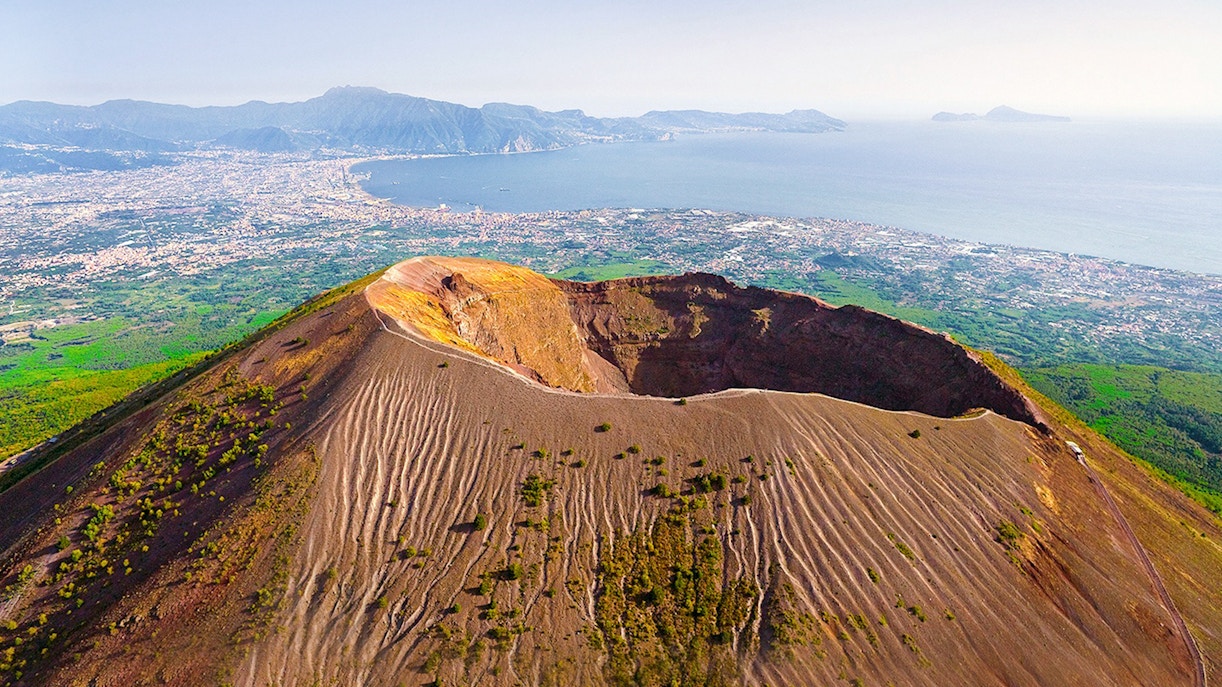- Size: Larger, more spread out
- Burial type: Covered in ash and pumice
- Highlights: Forum, amphitheater
- Atmosphere: Bustling city feel
Mount Vesuvius Entry Tickets
From Naples: Mount Vesuvius Entry Tickets with Round-Trip Transfers
From Pompeii: Mount Vesuvius Entry Tickets with Round-Trip Transfers
From Rome: Pompeii Guided Tour and Mount Vesuvius Day Trip
Hike up to the summit of Mount Vesuvius, the only active volcano on mainland Europe. At 1,281 meters, you’ll stand on the edge of a massive crater and witness steaming fumaroles—raw proof of the Earth's power.
Enjoy sweeping vistas of Naples, the Bay of Naples, Capri, and Pompeii from the crater rim. The combination of sky, sea, and volcano creates an unforgettable panorama.
Step onto the site of the infamous AD 79 eruption that froze Pompeii and Herculaneum in time. Vesuvius connects you directly to one of the most tragic events in Roman history.
Take a vineyard tour and taste wines like Lacryma Christi, grown in Vesuvius’s mineral-rich soil. Expect local delicacies, cellar visits, and a true flavor of the region’s heritage.
No visit to Vesuvius is complete without exploring Pompeii and Herculaneum. These UNESCO World Heritage Sites, buried by the AD 79 eruption, offer a fascinating look into ancient Roman life with remarkably preserved structures and artifacts.
Pompeii and Herculaneum were thriving Roman cities until the 79 AD eruption buried them under ash and rock. Today, you can still walk their streets, see preserved mosaics, and even visit homes frozen in time — a haunting reminder of how fast life changed in a single day.
Mount Vesuvius, located in the Campania region of Italy, near the Bay of Naples, is a stratovolcano known for its towering peak and steep slopes. It rises about 1,281 meters (4,203 feet) above sea level. It is known for its steep, conical shape. The geography around the volcano features a mix of fertile volcanic soil, rugged terrain, and lush vegetation, particularly on its lower slopes. The volcano's distinctive crater, formed from past eruptions, offers a dramatic landscape of volcanic rock and fumaroles, showcasing the dynamic nature of Italy's Mount Vesuvius.
Mount Vesuvius, famous for its deadly eruption in AD 79, has inspired all sorts of myths and legends over the centuries. One of the most well-known is the idea that the eruption was divine retribution against the decadent cities of Pompeii and Herculaneum. Back then, people often saw natural disasters as the gods' way of showing their displeasure, so it made sense to them that Vesuvius's eruption was a response to the cities' perceived moral decay.
The volcano was also linked to the Roman god Vulcan, the god of fire and metalworking. People believed that Vulcan's forge was located beneath Vesuvius, and that the eruptions were caused by his powerful hammering as he crafted weapons for the gods. This connection added a sense of mystery and divine power to the volcano, making it seem like more than just a natural phenomenon.
Mount Vesuvius is an active volcano and has the potential to be dangerous, but visiting the volcano is generally safe as long as visitors follow the guidelines and advice of local authorities. The Italian Civil Protection agency monitors the volcano closely and has systems in place to detect any signs of activity. In the unlikely event of an eruption, the authorities have evacuation plans in place to ensure the safety of visitors and local residents. Visitors are advised to stick to designated trails and follow the advice of their guide.

Mount Vesuvius is famous for its catastrophic eruption in AD 79, which buried the Roman cities of Pompeii and Herculaneum under volcanic ash and pumice. It remains one of the most well-known and studied volcanoes in the world. Its ongoing activity and dramatic eruptions make it a significant geological and historical landmark.
Predicting the exact timing of volcanic eruptions is challenging. Scientists use various monitoring techniques to assess volcanic activity and potential eruptions, but exact dates can't be determined.
There’s no strict age limit, but the hike can be challenging for young children and the elderly due to uneven terrain and elevation gain.
Pompeii's ruins were initially uncovered in the late 16th century by architect Domenico Fontana.
Karl Weber (1712-1764) was the pioneering archaeologist who meticulously explored Herculaneum, resulting in some of the most significant discoveries of the ancient world.
Yes, guided tours are available and often include transportation. These tours provide insights into the volcano’s history and geology, making the experience more enriching. You can visit the online tickets page to know more.
The hike takes about 20-30 minutes from the parking lot to the crater rim. It’s advisable to plan for a total visit time of around 2-3 hours.
No, vehicles can only go as far as the parking area below the summit. From there, it’s a short but steep hike to the top.
While gases are emitted, they’re not typically dangerous to visitors. However, it’s crucial to stay on designated paths and avoid the crater rim.
True or false: You can see smoke coming from the crater? ✅ Sometimes.
True or false: It only erupted once. ❌ 50+ known eruptions.
RECOMMENDED DURATION
4 hours
Timings
09:00–15:00
VISITORS PER YEAR
1000000
TICKETS
From $19.69
EXPECTED WAIT TIME - STANDARD
30-60 mins (Peak), 0-30 mins (Off Peak)